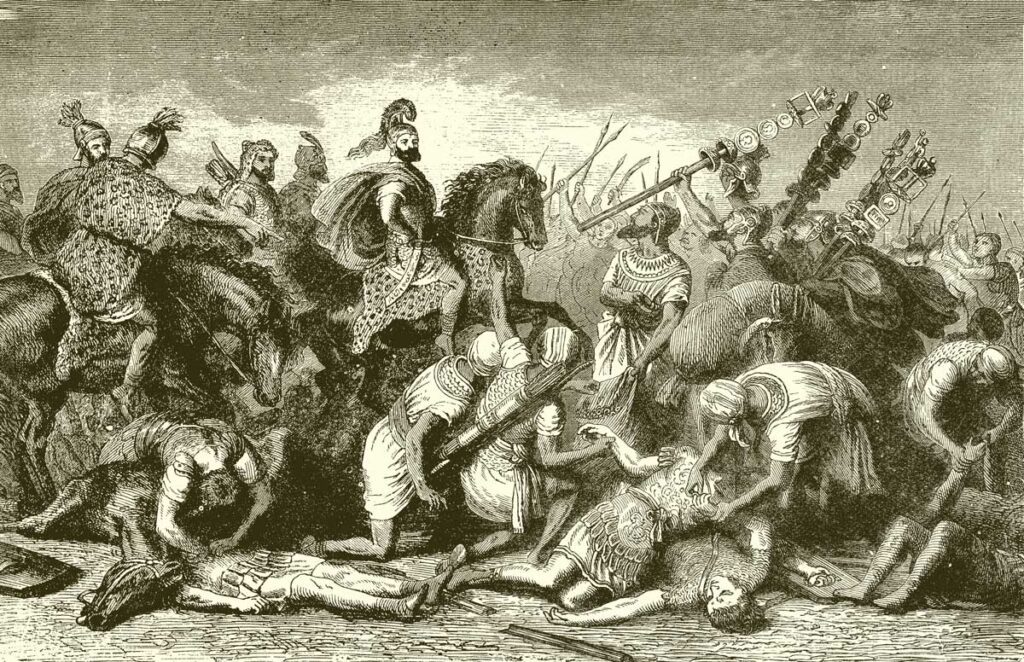The Battle of Cannae, fought in 216 BC during the Second Punic War, is renowned as one of the greatest military victories in history. Led by the brilliant general Hannibal Barca, the Carthaginian army strategically outmaneuvered the Roman Republic’s forces, culminating in a decisive victory. Hannibal’s innovative tactics, such as the “double envelopment” formation, have had a lasting impact on military strategy for centuries. Despite being outnumbered, Hannibal’s superior tactics and strategic genius secured a remarkable triumph that has inspired military commanders throughout history. The Battle of Cannae remains a testament to Hannibal’s exceptional military leadership and enduring legacy in the art of war.
The Battle of Cannae, fought in 216 BC during the Second Punic War, is often cited as one of the greatest military victories in history. The battle pitted the Carthaginian army, led by the brilliant general Hannibal Barca, against the Roman Republic’s forces. Hannibal’s innovative tactics and strategic genius not only secured a decisive victory for his army but also had a lasting influence on military tactics that would be studied and emulated for centuries to come.
### Background
The Second Punic War was a conflict between the Roman Republic and the Carthaginian Empire, led by Hannibal. The war began in 218 BC when Hannibal famously led his army, including war elephants, on a daring march through the Alps to invade Italy. Over the course of the war, Hannibal won several key battles against the Romans, including the Battles of Trebia and Lake Trasimene.
By 216 BC, the tide of the war had turned in favor of the Romans, who had mustered a massive army to confront Hannibal’s forces. The Roman Consuls, Lucius Aemilius Paullus and Gaius Terentius Varro, led an army of over 80,000 men to meet Hannibal on the battlefield near the town of Cannae in southern Italy.
### The Battle
Hannibal’s army, consisting of around 50,000 men, was significantly outnumbered by the Roman forces. However, Hannibal’s superior tactics and strategy would prove to be the deciding factor in the battle.
Prior to the battle, Hannibal deployed his troops in a crescent formation, with his African and Iberian infantry in the center and his Gallic and Numidian cavalry on the flanks. This formation, known as the “double envelopment,” would allow Hannibal to surround and encircle the Roman army once the battle began.
As the battle commenced, the Romans launched a frontal assault on Hannibal’s center, believing they could break through the Carthaginian lines. However, Hannibal’s troops slowly gave ground, drawing the Romans deeper into the trap. Once the Roman forces were fully engaged, Hannibal ordered his cavalry to encircle and attack the Roman flanks, cutting off their escape routes.
The Romans found themselves trapped in a deadly pincer movement, surrounded on all sides by Hannibal’s forces. The Carthaginian cavalry relentlessly attacked the Roman flanks, while the infantry closed in from the rear. In the chaos of the battle, the Roman forces were completely overwhelmed and suffered heavy casualties.
### Aftermath
The Battle of Cannae was a crushing defeat for the Romans, with an estimated 50,000 to 70,000 Roman soldiers killed in the battle. The loss was one of the worst in Roman history, and the defeat shook the very foundations of the Republic.
For Hannibal, the victory at Cannae was a crowning achievement in his military career. He had defeated a much larger and better-equipped Roman army through superior tactics and strategy. The battle solidified Hannibal’s reputation as one of the greatest military geniuses of all time.
The tactics employed by Hannibal at Cannae would have a lasting influence on military strategy for centuries to come. The concept of the double envelopment, where an army surrounds and encircles its enemy, became a common tactic used by military commanders throughout history. Hannibal’s successful use of this tactic at Cannae served as a model for future military leaders seeking to achieve victory against overwhelming odds.
In conclusion, the Battle of Cannae stands as a testament to Hannibal’s genius as a military commander. His innovative tactics and strategic brilliance paved the way for a decisive victory over the Roman Republic and left a lasting influence on military strategy that would be studied and admired for generations. The legacy of Hannibal’s triumph at Cannae continues to inspire military leaders to this day, demonstrating the enduring impact of his genius on the art of war.
